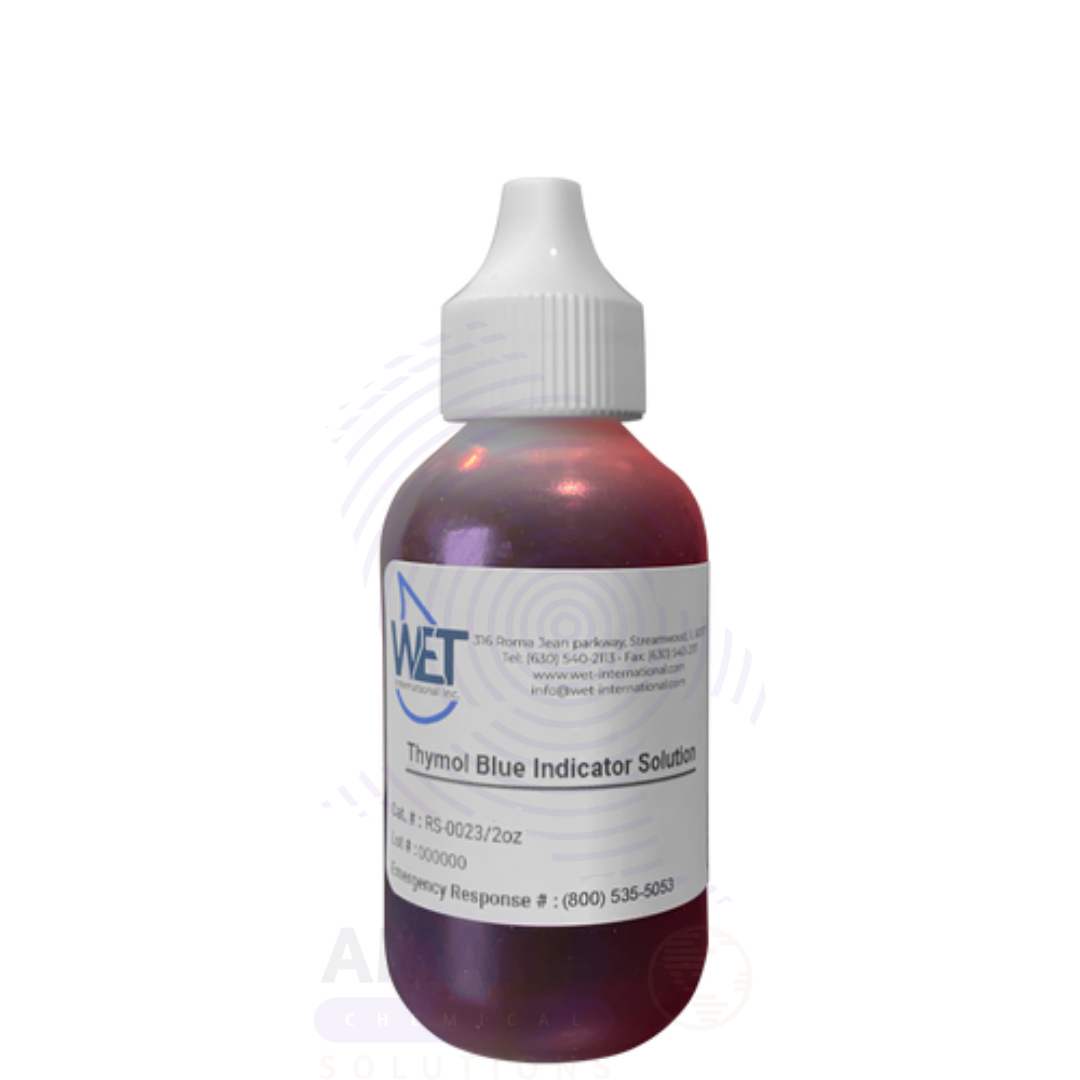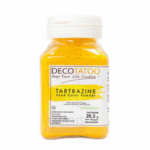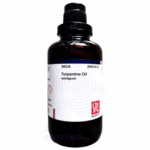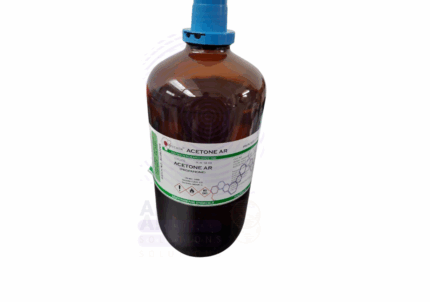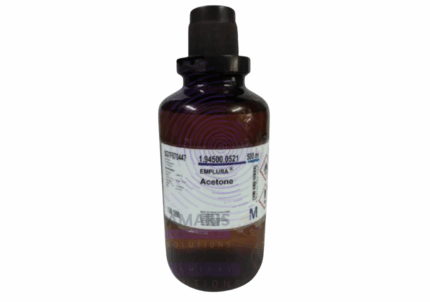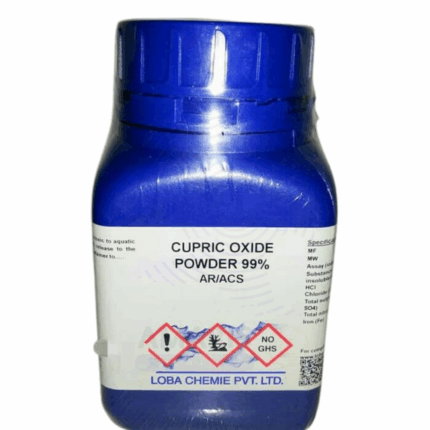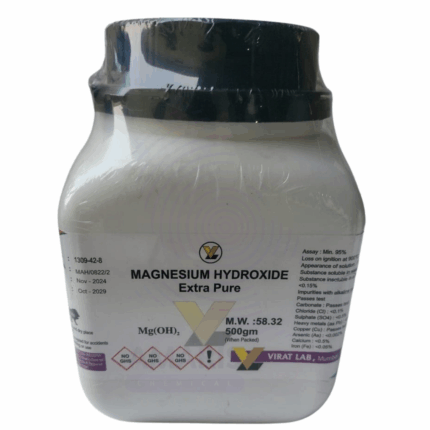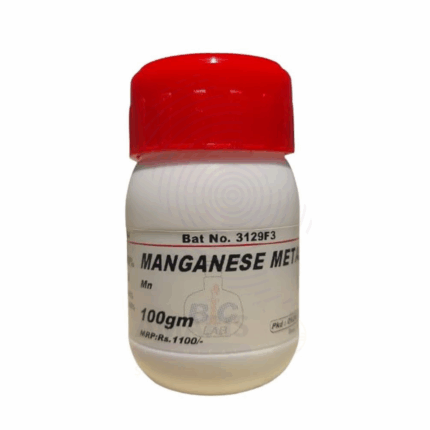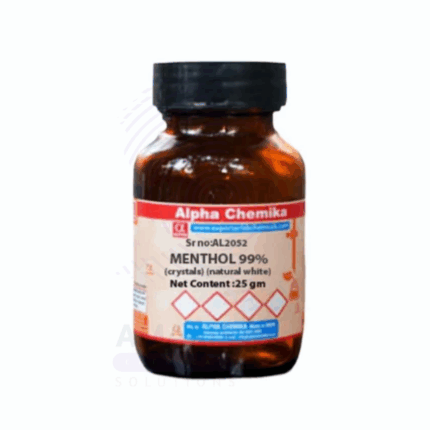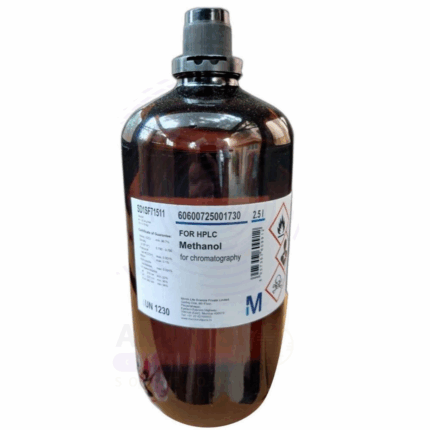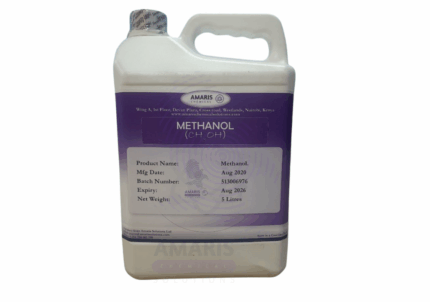Thymoil Blue Extra Pure
$ 18.21 Original price was: $ 18.21.$ 18.09Current price is: $ 18.09.
Thymoil Blue Extra Pure is a dual-range pH indicator and high-grade analytical reagent used extensively in laboratories for acid-base titrations, buffer preparation, and spectrophotometric measurements. It offers vivid and distinct color changes over two pH ranges, making it highly valuable for both quantitative analysis and educational demonstrations. This Extra Pure grade ensures minimal impurity and consistent behavior in sensitive experimental settings. Thymol Blue should be stored in a dry, cool, and dark environment to preserve its reactivity and accuracy.
Thymoil Blue Extra Pure
PRIMARY USES
- Analytical Reagent & Laboratory Applications
- Widely used as a pH indicator in titration and acid-base chemistry
- Displays a dual-color transition: red to yellow (pH 1.2–2.8) and yellow to blue (pH 8.0–9.6)
- Employed in buffer preparation and calibration of pH meters
- Serves as a reference dye in chemical, biochemical, and educational labs
- Applied in spectrophotometric experiments to study pH-dependent behavior of compounds
SECONDARY USES
- Educational & Demonstration Use
- Used in teaching laboratories to visually demonstrate pH changes and acid-base equilibria
- Common in chemistry kits and experiments for instructional purposes due to vivid color changes
1. Basic Identification Attributes
- Chemical Name: Thymol Blue
- CAS Number: 76-61-9
- HS Code: 3204.12.00
- Molecular Formula: C₂₇H₃₀O₅S
- Synonyms: Thymolsulfonephthalein, C.I. 18585, Acid Blue 93
2. Physical & Chemical Properties
- Physical State: Powder or crystalline solid
- Color & Odor: Reddish-brown to green powder, odorless
- Melting Point: ~221 °C (decomposes)
- Solubility: Slightly soluble in water; soluble in ethanol and alkaline solutions
- pH Transition Ranges:
– Red to yellow: pH 1.2–2.8
– Yellow to blue: pH 8.0–9.6 - UV-Vis Absorbance: Characteristic peaks depending on pH; used in colorimetric assays
- Stability: Light-sensitive; stable under normal storage when protected from light and moisture
3. Safety & Hazard Attributes
- Hazard Class (GHS Classification): Not classified as hazardous under normal laboratory use
- NFPA Ratings: Health 1, Flammability 0, Reactivity 0
- Exposure Limits: No specific OSHA or ACGIH exposure limits
- Reactivity: Stable under standard conditions; avoid strong oxidizers
4. Storage & Handling Attributes
- Storage Conditions: Store in a tightly sealed container in a cool, dry, and dark place
- Incompatible Materials: Strong oxidizing agents
- Container Type: Amber glass or opaque plastic to prevent light exposure
- Shelf Life & Expiration Date: Typically stable for 2–3 years if stored properly
- Special Handling Requirements: Handle with gloves and avoid inhalation of dust
5. Regulatory & Compliance Attributes
- Regulatory Status: Approved for laboratory and research use
- Transportation Restrictions: Not classified as hazardous for transport
- Waste Disposal Method: Dispose of in accordance with local environmental and chemical waste regulations
6. Environmental & Health Impact
- Ecotoxicity: Low at laboratory concentrations; avoid release into waterways
- Persistence in Environment: Moderately persistent; limited biodegradability
- Carcinogenicity/Mutagenicity: Not classified as carcinogenic or mutagenic
- Biodegradability: Organic dye; may degrade slowly in the environment
SAFETY PRECAUTIONS
Personal Protective Equipment (PPE):
- Wear lab gloves (e.g. nitrile)
- Use safety goggles or face shield
- Wear a lab coat
- Use dust mask if powder is airborne
Handling:
- Work in a well-ventilated space
- Avoid contact with skin, eyes, or clothing
- Avoid inhalation of fine dust
- Wash hands thoroughly after handling
Storage:
- Keep container tightly closed
- Store in a cool, dry, and light-protected area
- Avoid contact with incompatible substances
FIRST AID MEASURES
Inhalation:
- Move to fresh air
- Seek medical attention if symptoms develop
Skin Contact:
- Rinse skin with water and soap
- Remove contaminated clothing
- Seek medical advice if irritation occurs
Eye Contact:
- Rinse with clean water for 15 minutes
- Keep eyelids open while rinsing
- Seek immediate medical attention if irritation persists
Ingestion:
- Rinse mouth with water
- Do not induce vomiting
- Seek medical attention if any symptoms appear
FIRE FIGHTING MEASURES
Flammability:
- Not flammable under standard conditions
Extinguishing Media:
- Use dry chemical, water spray, foam, or carbon dioxide
Hazardous Combustion Products:
- May emit carbon monoxide, carbon dioxide, and sulfur oxides
Firefighter Protection:
- Wear SCBA and full protective gear
- Avoid inhalation of combustion fumes


 Preservatives(food)
Preservatives(food) Flavor Enhancers
Flavor Enhancers Acidulants
Acidulants Sweeteners
Sweeteners Antioxidants
Antioxidants Colorants(food)
Colorants(food) Nutraceutical Ingredients (food)
Nutraceutical Ingredients (food) Nutrient Supplements
Nutrient Supplements Emulsifiers
Emulsifiers
 Collectors
Collectors Dust Suppressants
Dust Suppressants Explosives and Blasting Agents
Explosives and Blasting Agents Flocculants and Coagulants
Flocculants and Coagulants Frothers
Frothers Leaching Agents
Leaching Agents pH Modifiers
pH Modifiers Precious Metal Extraction Agents
Precious Metal Extraction Agents
 Antioxidants(plastic)
Antioxidants(plastic) Colorants (Pigments, Dyes)
Colorants (Pigments, Dyes) Fillers and Reinforcements
Fillers and Reinforcements Flame Retardants
Flame Retardants Monomers
Monomers Plasticizers
Plasticizers Polymerization Initiators
Polymerization Initiators Stabilizers (UV, Heat)
Stabilizers (UV, Heat)
 Antifoaming Agents
Antifoaming Agents Chelating Agents
Chelating Agents Coagulants and Flocculants
Coagulants and Flocculants Corrosion Inhibitors
Corrosion Inhibitors Disinfectants and Biocides
Disinfectants and Biocides Oxidizing Agents
Oxidizing Agents pH Adjusters
pH Adjusters Scale Inhibitors( water)
Scale Inhibitors( water)
 Antioxidants(cosmetic)
Antioxidants(cosmetic) Emollients
Emollients Fragrances and Essential Oils
Fragrances and Essential Oils Humectants
Humectants Preservatives
Preservatives Surfactants(cosmetic)
Surfactants(cosmetic) Thickeners
Thickeners UV Filters
UV Filters
 Fertilizers
Fertilizers Soil Conditioners
Soil Conditioners Plant Growth Regulators
Plant Growth Regulators Animal Feed Additives
Animal Feed Additives Biostimulants
Biostimulants Pesticides (Herbicides, Insecticides, Fungicides)
Pesticides (Herbicides, Insecticides, Fungicides)
 Active Pharmaceutical Ingredients (APIs)
Active Pharmaceutical Ingredients (APIs) Excipients
Excipients Solvents(pharmaceutical)
Solvents(pharmaceutical) Antibiotics
Antibiotics Antiseptics and Disinfectants
Antiseptics and Disinfectants Vaccine Adjuvants
Vaccine Adjuvants Nutraceutical Ingredients (pharmaceutical)
Nutraceutical Ingredients (pharmaceutical) Analgesics & Antipyretics
Analgesics & Antipyretics
 Analytical Reagents
Analytical Reagents Solvents(lab)
Solvents(lab) Chromatography Chemicals
Chromatography Chemicals Spectroscopy Reagents
Spectroscopy Reagents microbiology-and-cell-culture-reagents
microbiology-and-cell-culture-reagents Molecular Biology Reagents
Molecular Biology Reagents Biochemical Reagents
Biochemical Reagents Inorganic and Organic Standards
Inorganic and Organic Standards Laboratory Safety Chemicals
Laboratory Safety Chemicals Specialty Laboratory Chemicals(Special Laboratory Equipment)
Specialty Laboratory Chemicals(Special Laboratory Equipment)
 Demulsifiers
Demulsifiers Hydraulic Fracturing Fluids
Hydraulic Fracturing Fluids Scale Inhibitors(oil)
Scale Inhibitors(oil) Surfactants(oil)
Surfactants(oil) Drilling Fluids
Drilling Fluids
 Dyes and Pigments
Dyes and Pigments Bleaching Agents
Bleaching Agents Softening Agents
Softening Agents Finishing Agents
Finishing Agents Antistatic Agents
Antistatic Agents
 Admixtures
Admixtures Waterproofing Agents
Waterproofing Agents Sealants and Adhesives
Sealants and Adhesives Curing Compounds
Curing Compounds Concrete Repair Chemicals
Concrete Repair Chemicals Anti-Corrosion Coatings
Anti-Corrosion Coatings
 Surfactants(cleaning)
Surfactants(cleaning) Builders
Builders Enzymes
Enzymes Solvents (Cleaning)
Solvents (Cleaning) Fragrances
Fragrances
 Electronic Chemicals
Electronic Chemicals Catalysts
Catalysts Lubricants
Lubricants Photographic Chemicals
Photographic Chemicals Refrigerants
Refrigerants Automotive chemicals
Automotive chemicals Pyrotechnic Chemicals
Pyrotechnic Chemicals
 Biodegradable Surfactants
Biodegradable Surfactants Bio-based Solvents
Bio-based Solvents Renewable Polymers
Renewable Polymers Carbon Capture Chemicals
Carbon Capture Chemicals Wastewater Treatment Chemicals
Wastewater Treatment Chemicals
 Pigments
Pigments Solvents(paint)
Solvents(paint) Specialty Coatings
Specialty Coatings Binders/Resins
Binders/Resins Additives
Additives Driers
Driers Anti-Corrosion Agents
Anti-Corrosion Agents Functional Coatings
Functional Coatings Application-Specific Coatings
Application-Specific Coatings
 Fresh Herbs
Fresh Herbs Ground Spices
Ground Spices Whole Spices
Whole Spices Spice Blends
Spice Blends Dried Herbs
Dried Herbs
 Leavening Agents
Leavening Agents Dough Conditioners
Dough Conditioners Flour Treatments
Flour Treatments Fat Replacers
Fat Replacers Decoratives
Decoratives Preservatives(baking)
Preservatives(baking)
 Plasticizers & Softeners
Plasticizers & Softeners Reinforcing Agents
Reinforcing Agents Adhesion Promoters
Adhesion Promoters Vulcanizing Agents
Vulcanizing Agents Antidegradants
Antidegradants Blowing Agents
Blowing Agents Fillers & Extenders
Fillers & Extenders Accelerators & Retarders
Accelerators & Retarders